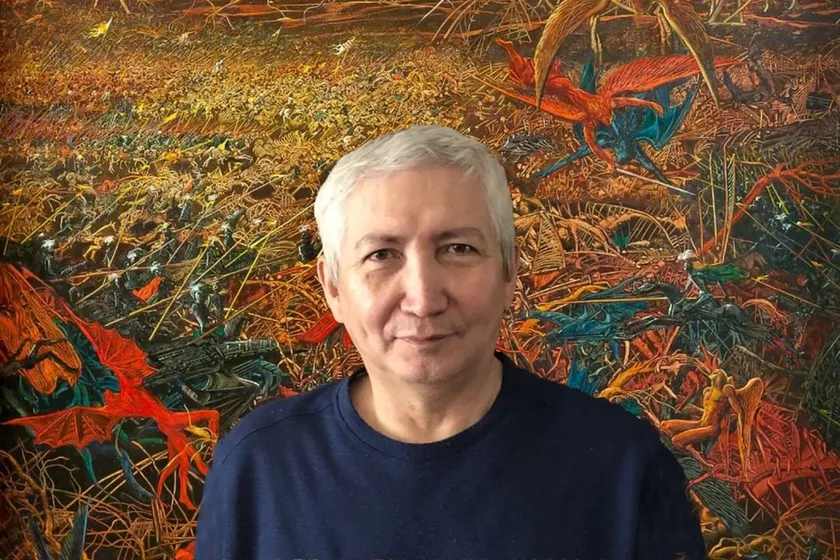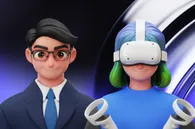Just a few weeks ago, Aibek Begalin finished working on Adventure - the latest painting carefully created at his home studio in Los Angeles. The Kazakh artist moved to the United States six years ago, leaving behind a decades-long legacy in Kazakh fine arts.
Begalin’s works are ubiquitous: they exist as museum displays in Kazakhstan and Russia and in private collections in Vatican, Japan, USA, Germany, France, Israel, England, Italy, Cuba, Monaco. His illustrations color the pages of Chingiz Aitmatov’s novels, and grace the album covers of rock bands abroad. Every citizen in Karagandy - the artist’s hometown - have a special connection to one of his timeless pieces, the city’s coat of arms.
The latest works of the 59-year-old artist produced in the US seem like a drastic departure from the original Apocalypse themed series he has been tightly associated with.
QazMonitor interviewed Aibek Begalin to find out how moving to a new country affected his creativity, how his paintings succeed in America, and how the US compares with his memories of home.
What were your first impressions of the US?
This is my first time in the United States. I had traveled to Europe before - and if I were to compare the experiences, America takes the upper hand. In Europe, no matter where I was - France, Netherlands, Belgium, or Germany - I felt like a foreigner. Even if I had moved to Europe, I would have been a foreigner there, not a real resident. And when I came to the US I realized that all Americans are like me - ninety-nine percent of them at least. Even those who are ‘old-timers’ - who had ancestors who had been here for 200 or 300 years - also came from immigrant families.
So there's no sense of being a stranger here. Everyone is in exactly the same position.
It feels very similar to the USSR; it’s a huge country with many republics, or states, and a very well-developed social service sphere. Everything reminds me of those times. The only thing is that there were no such upheavals as we had.
Can you recall your first painting after you moved?
‘A sunny day in LA’. It’s a portrait of Lyudmila, a woman from Moscow who came to visit her children in LA. I am good friends with her brother-in-law. They live in a beautiful house in Olympus with a view of Hollywood. About half a month after I arrived in the US, we visited them, and I really liked the view of the place and her as a character.
It took me about four days to paint the portrait. I think it captures the feeling of being in the sunshine. There are as many sunny days in LA as there aren't in St. Petersburg.
Several years ago, Kazakh art enthusiasts could enjoy your Apocalypse cycle of paintings, which look like the most captivating world apocalypse one could imagine. Those works were huge. But the tone has changed in your latest paintings. What caused such a change? Is your most famous cycle completed?
I don’t feel like this cycle is complete. Maybe the apocalypse series will be called something else, as I don't feel like touching on such overly tragic themes anymore. Let there be drama, but not so tragic. The artist is also affected by different events.
Right now, I gravitate towards miniatures - I’m working on small-sized still-life. You don't have to paint on huge canvases; the paintings can be just as complex on smaller ones.
Perhaps, Apocalypse will move to a new series but of a smaller size.
Many of your paintings have found new homes, as far as we know from the art market. Given the boom of the digital art industry, who are the buyers of conventional fine art?
There are private orders that can come from literally anybody. I can't really describe an average buyer. And now that there are sales on the Internet, I can only say that they are obviously young and middle-aged people. Nonetheless, I have made some paintings for my friends who are 70 years old. They came to Kazakhstan, and I painted a series of pictures for them of people they've wanted to have portraits of for a very long time. Sports idols and their friends in life. So, you can say that the audience is from 30 to 70 years old.
As for the online marketplaces, I discovered them here. I hadn’t done online sales seriously before. Many artists are actively using these opportunities today. I think the reason is that websites like Saatchi Art, ArtFinder, or Singulart guarantee the buyer a refund or a return option on delivery if they don't like it.
Your creative output has been very prolific in recent years - 44 sales on Saatchi Art ranging from several hundred to $8,000. What keeps the creativity flowing?
I think people here are generally more active because life drives you to be busy all the time. Here, I work even more than in Kazakhstan - maybe because of the atmosphere. You have to be active to show yourself, to look for new ways, and new forms.
Your latest work, Adventure, is a new miniature you’ve mentioned. Is there some sci-fi time travel element to it? What does that painting convey?
It gives off a feeling of being in a modern fantasy about time travelers and magic. It’s about a hero who finds himself in other worlds and circumstances. The hero is accompanied by people in antique or medieval attire. Behind the tree, you can see a portal to another dimension. I wanted to convey that feeling of entering another world.
Thank you so much for the interview. Can we expect to see your paintings displayed in Kazakhstan soon?
I can't say yet, because during the pandemic the focus shifted to working over the internet. Before that, I had participated several times in exhibitions at the Beverly Hills Art Show and two solo exhibitions. Now I'm not planning to do any. I mostly want to work with online venues. They are all different and present the artist in different ways.
It's hard to predict the future, but I think it's surely possible to have an exhibition in Kazakhstan.










